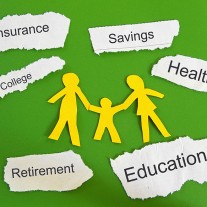


Manageable Goals
Keeping track of your finances is not fun and is generally something we forget to do. Neglecting this can be have negative consequences. You may end up spending more than you make which can lead to debt. Debt can become overwhelming. Here are some steps in order to help you start thinking about your finances and even how to start saving and thinking about the future.
Pay Off Your Debt
The first step in making your money work for you is to pay off your debt. Take a look at the monthly activity of your bank account and figure out how much of your money is going in to paying off your debt. This does not only include the original amount that you borrowed, but the interest you are now paying on top of it. If you have more than one source of debt, try going to your bank and asking for all of your debt to be consolidated so that you are paying a fixed rate. Do not start a savings account at this time, unless it is an emergency savings account (that is, money that can sustain you for 3 to 4 months, if you lose your job).
Set Goals
 As mentioned earlier, the first goal that you should set out to accomplish is paying off your debt. Once this is done you can move on to begin accumulating some of your money and using it for future goals. There are 2 types of goals: short term and long term. Short term and long term refer to length of time. Short term goals could include buying a new suit or getting a car. A long term goal could mean saving for retirement. It is now important to come up with manageable “bite size” steps in order to reaching these goals. Figuring out how much money you can reasonably put aside for your goal can be one of these steps. Again, take a look at your bank account. How much are you spending on rent, groceries, and bills? Subtract these expenses from the amount you bring in each pay cheque, week or month. How much of this can you put aside for your goals while still meeting your needs and not getting bad credit? Once you’ve figured out how much you can put aside, then figure out how long it will take to reach the goal while paying in these instalments.
As mentioned earlier, the first goal that you should set out to accomplish is paying off your debt. Once this is done you can move on to begin accumulating some of your money and using it for future goals. There are 2 types of goals: short term and long term. Short term and long term refer to length of time. Short term goals could include buying a new suit or getting a car. A long term goal could mean saving for retirement. It is now important to come up with manageable “bite size” steps in order to reaching these goals. Figuring out how much money you can reasonably put aside for your goal can be one of these steps. Again, take a look at your bank account. How much are you spending on rent, groceries, and bills? Subtract these expenses from the amount you bring in each pay cheque, week or month. How much of this can you put aside for your goals while still meeting your needs and not getting bad credit? Once you’ve figured out how much you can put aside, then figure out how long it will take to reach the goal while paying in these instalments.
Keep Track Of Your Expenses
It is a good idea to start comparing how much you spend with how much you make. To do this, take a look at your account activity in the past month or two. Then, try to figure out what the money you withdrew was spent on. You may need to start your own record of expenditures. In order for this to work make sure to try and be as specific as possible with every item you purchased (i.e. that can of soda, the fancy jam).
Budget
The first step in budgeting is figuring out your own budget. Now that you have paid off your debt and curbed some of your more excessive spending, figure out how much extra money you’ll have to spend on whatever it is you choose to spend on. Another thing you can do is stop using your credit cards. You don’t have to stop using them completely. There are instances where you may need them (i.e. an emergency, or paying an online bill), but make sure that you keep them paid off.

Open a savings account. Set aside some of your wages each paycheck and put it towards the future. You could also consider putting some of your money into your 401K or something a little longer term. Make this a priority. You can have a certain amount of your payment immediately deducted from your paycheck and put into your savings account or 401K.
Conclusion
In this article we looked at the importance of paying off your debt, setting goals, keeping track of expenses and budgeting. We looked at some of the ways you can begin to save money (i.e. planning and setting goals, not using credit cards, opening up a savings account, etc.). It is important to pay attention to your money in order to get ahead.












